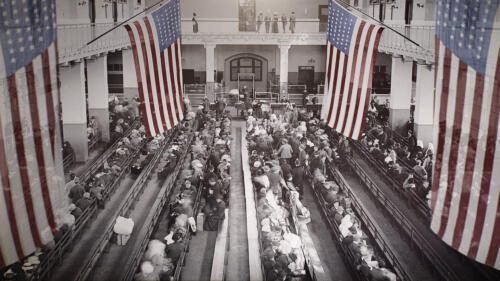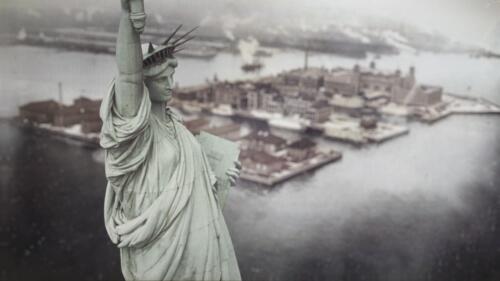Immigration
Immigration, the movement of people from one country to another, is a fundamental aspect of human history, though it was as divisive hundreds of years ago as it is today.

Start Here

Attitudes and laws around U.S. immigration have vacillated between welcoming and restrictive since the country's beginning.

An Ellis Island clerk and amateur photographer captured the wide-ranging origins of immigrants entering the United States in the early 1900s.

The act put an end to long-standing national-origin quotas that favored those from northern and western Europe.

In 1929, Section 1325 criminalized undocumented immigration for the first time. Its aim was to decrease Mexican immigration.
How the Cold War Contributed to the Modern Central American Migrant Crisis
How the Cold War Contributed to the Modern Central American Migrant Crisis
For decades migrants from Central America have fled their homes from corruption, crime, poverty and violence to seek a better life in the United States. One of the major causes of such strife? The Cold War.
3 Key Laws
Explore All Related Topics

Annie Moore was a teenager from Ireland; Arne Petterssen was a Norwegian seaman who had overstayed his shore leave in New York.

The US and Puerto Rican governments, looking to solve mutual problems, actively facilitated the exodus.

The first major period of Arab immigration started around 1880, when residents of the Ottoman Empire began to come to the United States.

The act put an end to long-standing national-origin quotas that favored those from northern and western Europe.

In 1929, Section 1325 criminalized undocumented immigration for the first time. Its aim was to decrease Mexican immigration.

Opportunity in the United States beckoned—but first immigrants from Europe had to endure a grim journey.

The passionate relationship between Americans and pizza may have begun with Filippo Milone, an Italian baker who faded into obscurity.

Attitudes and laws around U.S. immigration have vacillated between welcoming and restrictive since the country's beginning.

An Ellis Island clerk and amateur photographer captured the wide-ranging origins of immigrants entering the United States in the early 1900s.

Photographer Jacob Riis exposed the squalid and unsafe state of NYC immigrant tenements.

More than 12 million immigrants passed through the doors of the storied station. See photos from its peak years.

Most may not think of Mexico as contributing to the Allied effort, but it contributed key resources, as well as fighting power.

For decades, they denied their German roots, claiming to be of Scandinavian origin.

In 1907, no passports or visas were needed to enter the United States through Ellis Island. In fact, no papers were required at all.

Woodrow Wilson thought German Americans couldn't assimilate.

As many as 1.3 million people may have been swept up in the Eisenhower-era campaign called 'Operation Wetback.'

Lawmakers thought focusing on family unification would preserve the immigration status quo. The result was just the opposite.

The history behind the program Trump wants to scrap.

The Irish Potato Famine was caused by a potato disease in Ireland in the mid-1800s. The “Great Hunger” killed about 1 million people, forcing another million to emigrate.

For a long time, it wasn't possible to immigrate illegally to the U.S.

French Louisiana New France-the North American territories claimed by France-once extended from Hudson Bay in present-day Canada to the Gulf of Mexico, and from the shores of the North Atlantic to the Great Plains. In 1682, the French claimed what came ...

Chinese Immigration to the United States Most of the early Chinese immigration to the United States can be traced to the mid-1800s. These early immigrants—some 25,000 in the 1850s alone—came seeking economic opportunity in America. The Chinese arriving ...

Irish immigrants overcame discrimination after fleeing home for American cities like Boston, now known as a hub of Irish-American history and culture.

Quakers, or the Religious Society of Friends, was founded in England in the 17th century by George Fox and played a key role in abolition and women’s suffrage.

On the anniversary of the opening of Ellis Island, learn about the first foreigner who passed through its doors, 17-year-old Irish immigrant Annie Moore.

Check out nine surprising facts about the port that once served as the main entryway to America.

After nearly two centuries, scientists have identified the plant pathogen that devastated Ireland, killing 1 million people and triggering a mass emigration.

Tenements were low-rise apartment buildings, known for cramped spaces and poor living conditions, that emerged in urban centers like New York City in the 1800s.

The Immigration and Naturalization Act of 1965, also known as the Hart-Celler Act, abolished an earlier quota system based on national origin and established a new immigration policy based on reuniting immigrant families and attracting skilled labor to the United States.

Immigration in the Colonial Era From its earliest days, America has been a nation of immigrants, starting with its original inhabitants, who crossed the land bridge connecting Asia and North America tens of thousands of years ago. By the 1500s, the firs...

The Gentlemen's Agreement of 1907 was an informal agreement between the United States of America and the Empire of Japan whereby Japan agreed to deny passports to laborers intending to enter the United States and the US would not impose restrictions on Japanese immigrants already in the country.

Ellis Island, a historical site in New York City, opened in 1892 as an immigration station and processed more than 12 million immigrants until it closed in 1954.



















